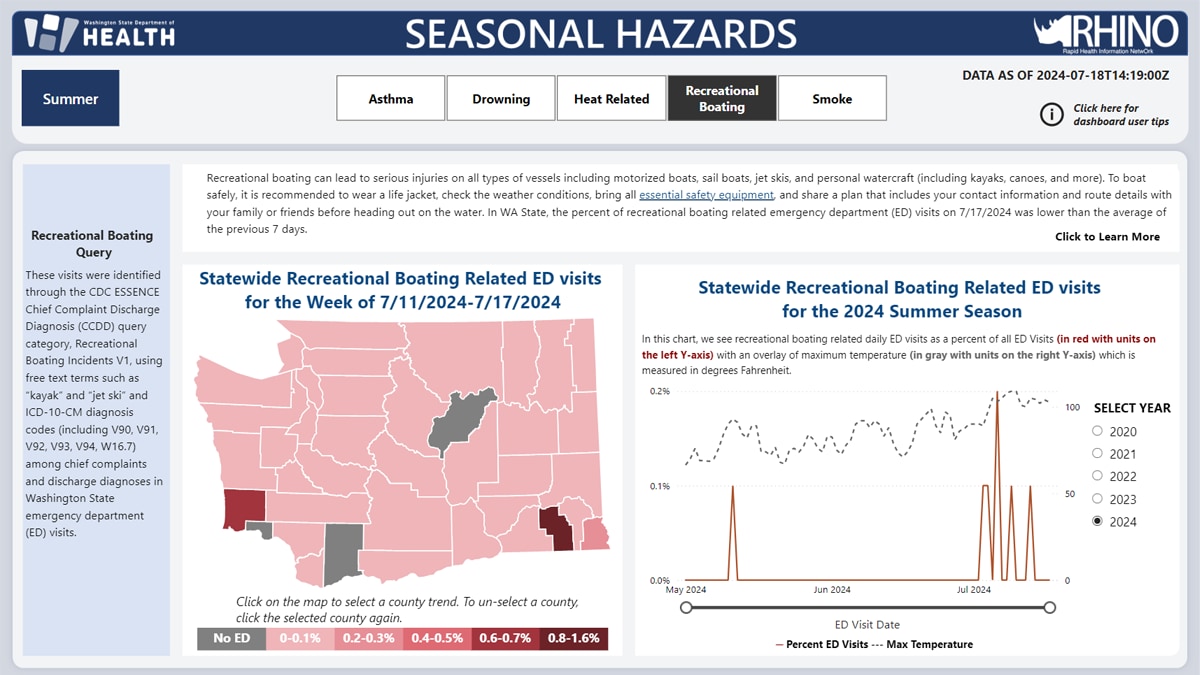Highlights
- Concerns about underreporting of non-fatal recreational boating injuries — potentially hindering prevention activities — led to a partnership to improve surveillance.
- This effort resulted in the development of new, validated methods to monitor recreational boating injury trends within syndromic surveillance data.
- Partnerships between public health and boating injury prevention experts can facilitate leveraging multiple data sources for improved surveillance and resource allocation.

Public health problem
In Washington state, recreational boat operators are required by 33 CFR 173.55 to report serious incidents to local law enforcement agencies. A Washington Boat Accident Report must be filed:
- When an individual dies, disappears or suffers an injury that requires treatment beyond first aid.
- When property damage equals or exceeds $2,000.
- When a vessel is totaled.
However, many non-fatal incidents go unreported, which can make it difficult to monitor injury trends and respond to increases.
Actions taken
To improve non-fatal recreational boating injury surveillance, a cross-sectoral partnership was created between the Washington State Department of Health Rapid Health Information NetwOrk, Washington State Parks & Recreation, the U.S. Coast Guard, the National Association of State Boating Law Administrators, and the Safe States Alliance. The partnership aimed to pilot recommendations and frameworks to improve non-fatal boating injury surveillance through the use of public health data.
One of the public health data sources included in this partnership was near real-time electronic health record data from CDC’s NSSP. This program collects data from visits in emergency departments (EDs) and urgent cares. Custom syndrome definitions can inform queries to identify visits related to an issue of public health concern — leaving out unrelated visits. In this project, the NSSP team collaborated with the U.S. Coast Guard to pilot a syndrome definition for recreational boating incidents. Six public health jurisdictions — Florida, North Dakota, Michigan, Tennessee, Washington and Wisconsin — also contributed to this effort.
The syndrome definition they developed incorporated:
- Free-text terms related to the patient reason for the visit (the chief complaint).
- Discharge diagnosis codes related to recreational boating injuries.
The six jurisdictions were asked to review and validate the definition’s performance. This led to the finalization of the first version of the definition (Recreational Boating Incidents v1) and its implementation into ESSENCE, a key surveillance tool that NSSP makes available to public health departments.
The partnership also compared the number of non-fatal recreational boating injuries identified by Washington state’s emergency medical system (EMS), syndromic surveillance, and boating law enforcement databases. Overall, EMS responses and urgent care and ED visits far exceeded the non-fatal injuries in the boating law enforcement database. This suggests that relying solely on information reported to the boating law enforcement database allows many injuries to go undetected by public health.
Additionally, the partnership linked data across syndromic surveillance and boating accident report form databases to leverage contextual information. The goal was to answer key injury prevention questions such as “How does travel influence on-the-water safety and recreational boating injuries?” Using diverse, contextually rich data systems enables investigation of questions that would not be possible with a single data system.
The partnership is an example of a successful collaboration across diverse government and non-profit agencies. To support other jurisdictions in forming similar collaborations, the partnership has recorded the process steps needed to complete the pilot project. Successes, challenges and lessons learned throughout the collaboration were also documented.
Outcomes
Five key outcomes were achieved through this partnership:
- The first validated method to identify recreational boating injury ED visits has been released in ESSENCE for use across the nation. See the Recreational Boating Incidents V1 CCDD Category.
- This effort helped to confirm concerns that many non-fatal injuries related to boating were going unreported. Syndromic surveillance ED and urgent care data identified over 10 times the number of recreational boating injuries identified through accident report form data. Additionally, about 95% of the non-fatal recreational boating injuries identified by syndromic surveillance were unable to be linked to accident reports. These findings highlight a need for public health data systems to help improve the capture and representativeness of boating injury data.
- Travel has been identified as a key factor for injury prevention planning and resource allocation efforts. Almost half of all linked boating injuries involved patients who injured themselves on waterways outside their residence county or state. (Boating injuries were linked through injuries identified in both boating accident report forms and syndromic surveillance visit data.)
- Rapid Health Information NetwOrk has included recreational boating injuries on the Washington State Department of Health’s public-facing Seasonal Hazards Dashboard.

- The partnership created a report to support other jurisdictions that may be interested in similar collaboration. See Improving Recreational Boating Surveillance: A manual for state boating law administrators and public health epidemiologists.
Resources
Washington State Department of Health
Rapid Health Information NetwOrk Program
RHINO@doh.wa.gov
William Wallace, Management Analyst
Washington Parks and Recreation, Recreational Boating Safety Program
william.wallace@parks.wa.gov
Ron Sarver, Interim Executive Director
National Association of State Boating Law Administrators
ron@nasbla.org
Jonathan Hsieh, Management and Program Analyst
US Coast Guard, National Recreational Boating Safety Program
jonathan.c.hsieh2@uscg.mil
Susan Weber, Statistician
US Coast Guard, National Recreational Boating Safety Program
susan.m.weber@uscg.mil
Centers for Disease Control and Prevention
Office of Public Health Data, Surveillance, and Technology
Detect and Monitor Division
www.cdc.gov/nssp
The findings and outcomes described in this syndromic success story are those of the authors and do not necessarily represent the official position of the National Syndromic Surveillance Program or the Centers for Disease Control and Prevention.
